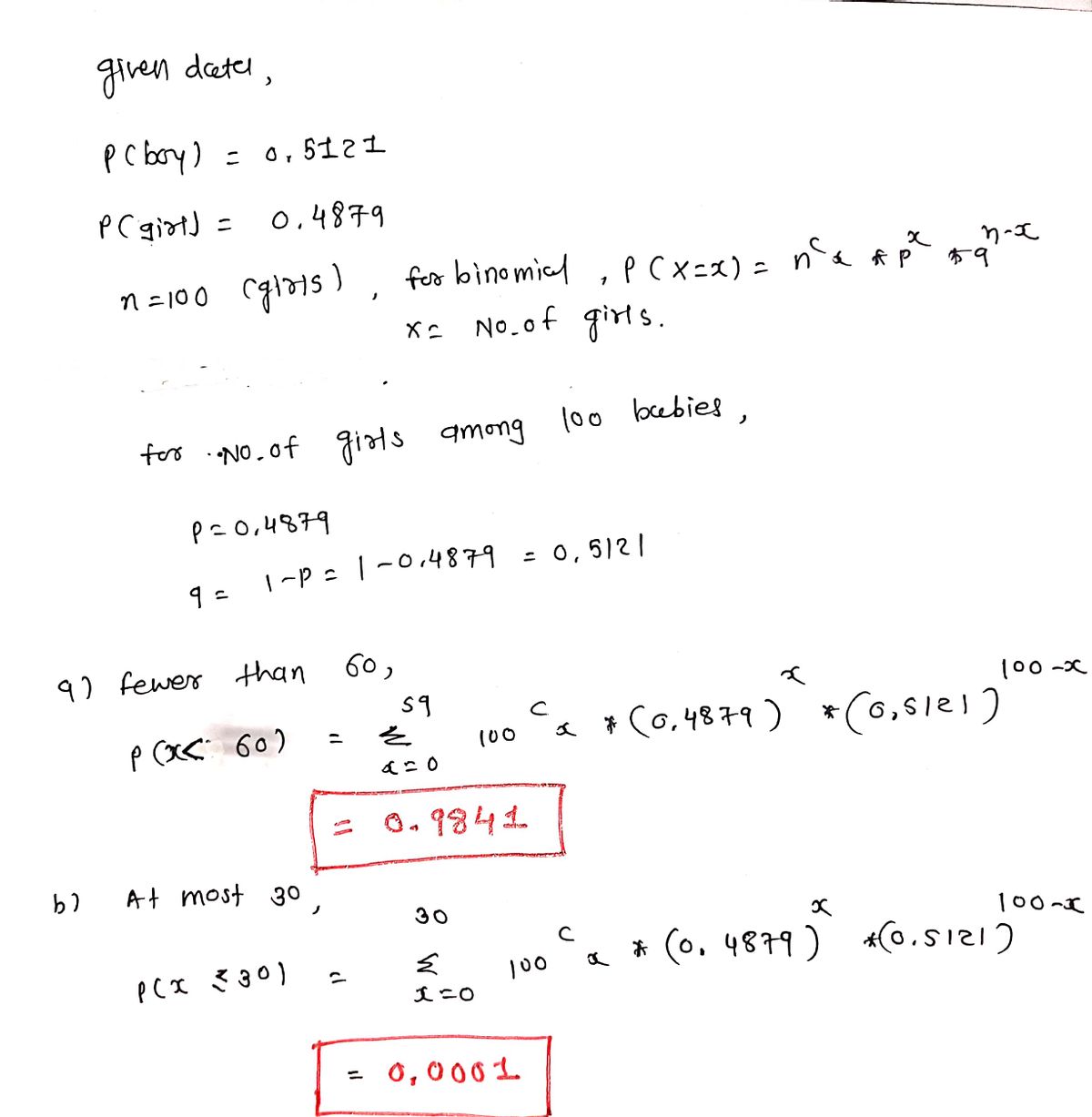1. Assume that P(boy) = 0.5121, P(girl) = 0.4879, and that 100 births are randomly selected. %3D Use Minitab to find the probabilities that the number of girls among 100 babies is a. Click Calc and select Probability Distributions and then Binomial... b. For probabilities that are less than or equal to make sure Cumulative probability is selected and for probabilities that are equal to make sure that Probability is selected C. Enter the value for n in the box for Number of trials d. Enter the probability of a success in the Event probability box e. Make sure Input constant is selected and enter the value of x in the box f. Click OK i. Fewer than 60. ii. At most 30.
1. Assume that P(boy) = 0.5121, P(girl) = 0.4879, and that 100 births are randomly selected. %3D Use Minitab to find the probabilities that the number of girls among 100 babies is a. Click Calc and select Probability Distributions and then Binomial... b. For probabilities that are less than or equal to make sure Cumulative probability is selected and for probabilities that are equal to make sure that Probability is selected C. Enter the value for n in the box for Number of trials d. Enter the probability of a success in the Event probability box e. Make sure Input constant is selected and enter the value of x in the box f. Click OK i. Fewer than 60. ii. At most 30.
MATLAB: An Introduction with Applications
6th Edition
ISBN:9781119256830
Author:Amos Gilat
Publisher:Amos Gilat
Chapter1: Starting With Matlab
Section: Chapter Questions
Problem 1P
Related questions
Concept explainers
Contingency Table
A contingency table can be defined as the visual representation of the relationship between two or more categorical variables that can be evaluated and registered. It is a categorical version of the scatterplot, which is used to investigate the linear relationship between two variables. A contingency table is indeed a type of frequency distribution table that displays two variables at the same time.
Binomial Distribution
Binomial is an algebraic expression of the sum or the difference of two terms. Before knowing about binomial distribution, we must know about the binomial theorem.
Topic Video
Question
100%

Transcribed Image Text:posh/Desktop/Lab%203m.pdf
1. Assume that P(boy) = 0.5121, P(girl) = 0.4879, and that 100 births are randomly selected.
Use Minitab to find the probabilities that the number of girls among 100 babies is
a. Click Calc and select Probability Distributions and then Binomial..
b. For probabilities that are less than or equal to make sure Cumulative probability is
selected and for probabilities that are equal to make sure that Probability is
selected
c. Enter the value for n in the box for Number of trials
d. Enter the probability of a success in the Event probability box
e. Make sure Input constant is selected and enter the value of x in the box
f. Click OK
i Fewer than 60.
ii. At most 30.
iii. Equal to 45
iv. At least 55.
v. More than 40.
0耳
W
hulu
18
Expert Solution
Step 1

Trending now
This is a popular solution!
Step by step
Solved in 2 steps with 2 images

Knowledge Booster
Learn more about
Need a deep-dive on the concept behind this application? Look no further. Learn more about this topic, statistics and related others by exploring similar questions and additional content below.Recommended textbooks for you

MATLAB: An Introduction with Applications
Statistics
ISBN:
9781119256830
Author:
Amos Gilat
Publisher:
John Wiley & Sons Inc

Probability and Statistics for Engineering and th…
Statistics
ISBN:
9781305251809
Author:
Jay L. Devore
Publisher:
Cengage Learning

Statistics for The Behavioral Sciences (MindTap C…
Statistics
ISBN:
9781305504912
Author:
Frederick J Gravetter, Larry B. Wallnau
Publisher:
Cengage Learning

MATLAB: An Introduction with Applications
Statistics
ISBN:
9781119256830
Author:
Amos Gilat
Publisher:
John Wiley & Sons Inc

Probability and Statistics for Engineering and th…
Statistics
ISBN:
9781305251809
Author:
Jay L. Devore
Publisher:
Cengage Learning

Statistics for The Behavioral Sciences (MindTap C…
Statistics
ISBN:
9781305504912
Author:
Frederick J Gravetter, Larry B. Wallnau
Publisher:
Cengage Learning

Elementary Statistics: Picturing the World (7th E…
Statistics
ISBN:
9780134683416
Author:
Ron Larson, Betsy Farber
Publisher:
PEARSON

The Basic Practice of Statistics
Statistics
ISBN:
9781319042578
Author:
David S. Moore, William I. Notz, Michael A. Fligner
Publisher:
W. H. Freeman

Introduction to the Practice of Statistics
Statistics
ISBN:
9781319013387
Author:
David S. Moore, George P. McCabe, Bruce A. Craig
Publisher:
W. H. Freeman